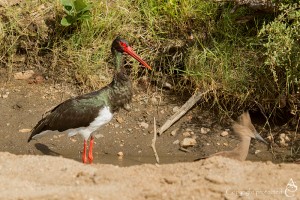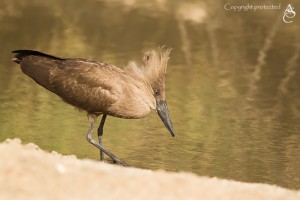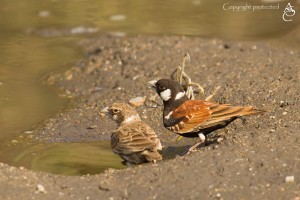And so, the fateful day arrived – the day we had to leave the park.
The sun was up early, but – frustratingly – we couldn’t be out of the camp early. We needed to load the car, and we couldn’t get up earlier to do so, since hubby needed to be rested for the long road back to Pretoria.
We were ready to leave just after 7, but first, we wanted to continue the tradition we started on our last trip – driving through the camp with the GoPros recording, to make a video of the camp.
Then we dropped off the keys, and said goodbye to Letaba, while vowing to be back some day!
We took the main road to Phalaborwa gate. After looking for, but not finding the Hyena clan we say earlier, we turned into the S69. Because one cannot just drive straight to the gate!
 The morning was quiet, with very little game around. At the Nhlanganini river crossing, we stopped. There was a Black Stork and a Hammerkop hunting in one of the pools to the left of the road.
The morning was quiet, with very little game around. At the Nhlanganini river crossing, we stopped. There was a Black Stork and a Hammerkop hunting in one of the pools to the left of the road.
As we sat watching them, we got a quick glimpse of another new lifer – a Black Coucal! And just to make the collection complete – a pair of Chestnut-backed Sparrow-Larks came down to drink, bringing our specie-count up to 97!
 |
 |
We continued on, turning into the S51, to take the long route to visit Sable one last time.
Once again, Sable dam didn’t disappoint – elephants, elephants and more elephants! Not wanting to get out the gate too late, we didn’t stay long. However – the herds had other plans for us! They were all over the bush in the vicinity of the hide, and some were blocking the road! Even after the road-blockers moved off, there were a hand full of elephants browsing next to the road, and every time we tried to pass, they would face us and their body language would be quite clear – stay away, we’re eating here! So we’d stop again. After a full hour, the largest one turned his back, and started sampling a different tree just a meter or two further from the road, and we took our chance. She still turned around and gave us a “look”, but by then we were already past her, and we only saw her flap her ears in annoyance in the rear-view mirror. Phew! We were free!
Too late, we realized that with all the adrenaline pumping, neither of us had thought to switch on a GoPro! We had no footage whatsoever of the entire experience!
Back on the tar road, we saw more vulture, they were some distance from the road, but we were able to identify two more species:
- Lappet-faced Vulture
- White-headed Vulture
We reached the gate just before 12, with our birding list at 99. But it wasn’t over yet!
We stopped in the parking area, for a last leg stretch before the long road home, and also to get some cool drinks from the shop, use the bathroom, and put away the cameras and GoPros.
And of course we weren’t about to ignore the birds at the gate, and added a few more:
- Tawny-flanked Prinia
- Southern Black Flycatcher
- Southern Masked Weaver
- Cut-throat Finch
- Chinspot Batis
Final Bird count for the trip: 104. We beat our target with a full 29 species!
Final thoughts
About the hide:
Shipandane hide was brilliant. We will definitely be back. Next time I will try to time the trip for an earlier moon rise.
About Letaba:
Letaba was great, as was our bungalow. We enjoyed the camp very much, and will definitely be back. Next time I will try again for number 64, but I will be perfectly happy if I have to settle for 63 again. We had no complaints about it. It would be nice if the bungalows were upgraded to the standard of the one we had last time in Satara, but at the same time, there was something nostalgic about the green tiles and the too-low shower head. It’s Kruger, after all. If we wanted luxury, we would book into a lodge. The bungalow was spotlessly clean, and had everything we needed. We don’t ask for more than that in Kruger.
About the area:
The area around Letaba was stunningly beautiful. I don’t know if that is always they case, or how much of the beauty was due to the rains of December and January. As expected, wildlife wasn’t as abundant as further South, but the bird life exceeded our expectations.
About the weather:
The weather was far from brilliant – in fact, at times it was quite foul, but it failed to spoil the trip. If, as we did until a few years ago, we were focused solely on photography, the lack of good light would have been very frustrating. However, with birding in the mix, we were never bored.
Above all – this trip accomplished its primary goal. We arrived back home relaxed, refreshed, and fully recharged.
